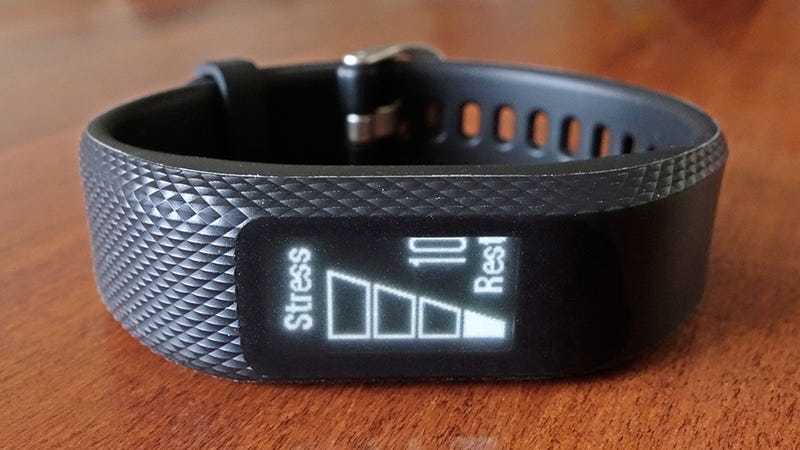
Staying active is a big part of staying healthy, and that’s often the reason given for why you should wear a fitness tracker; they’re a constant reminder to get up off the couch. But stress can be just as detrimental to your health as sloth, so Garmin hopes its new vívosmart 3 will finally quantify what you already know: you need a vacation. Besides all the features we’ve comes to expect from a fitness tracker, the vívosmart 3 has a stress tracker built in too.
The Garmin vívosmart 3 is an update to the late 2015 eyesore, the vívosmart HR. Like the vívosmart HR, the new vívosmart 3 doesn’t include any GPS hardware for tracking a running or cycling route. That’s odd coming from Garmin—a company notable for its GPS tech. Yet it’s also a minor trade-off which results in a fitness tracker that doesn’t look as bulky as a smartwatch, despite also being able to receive vibrating alerts for emails, messages, phone calls, and appointments when connected to the Garmin app on a smartphone.
The lack of bulk isn’t just a welcome change from other smartwatches, but the vívosmart HR as well. A year and a half of technological advancement has resulted in a smaller, sleeker fitness tracker that, among other improvements, is just more comfortable to wear.
Though that’s not a terribly difficult feat to accomplish. The vívosmart HR is monstrous compared to the new vívosmart 3. The protruding heart rate sensor and LEDs on the older model dug into my wrist, making it uncomfortable for me to wear.
In the vívosmart 3 that lump has been reduced to a barely noticable bump more in line with heart rate trackers on other wearables. Garmin claim’s the new model measures everything you’d expect a fitness tracker equipped with a heart rate sensor to quantify, but Garmin is also introducing two additional metrics for VO2 max levels and stress.
VO2 max (also known as maximal oxygen consumption) is a metric designed to give athletes an indication of their overall physical fitness. If you’ve ever seen a professional athlete running on a treadmill while wearing a breathing apparatus, that device is calculating their VO2 max. Last year Fitbit claimed to be able to measure the number with nothing but a heart rate monitor, and Garmin is now making the same claim, helpfully translating the number to a fitness level score ranging from poor to superior. Until we get a chance to hop on a treadmill and pick up an oxygen mask you’ll want to take that metric with a grain of salt.
More useful to non-athletes struggling to find the time (and motivation) to stay fit, is the vívosmart 3’s claimed ability to assess stress levels by measuring variations in a wearer’s heart rate. The results are delivered via a simple graph, and the wearable can even walk you through breathing exercises to help you relax. It’s a clever way to reinterpret a user’s heart rate data, and a feature that companies like Fitbit don’t offer yet. Yet a couple of goofy Kickstarters have made similar claims, and were quickly noted to be virtually incapable of accuracy. Without additional context about someone’s lifestyle and health, measure stress via heart rate is far from being an accurate, and definitely not a replacement for doctor’s consultation.
The vívosmart 3 also includes a mostly-improved display compared to the always-on but unlit LCD display on the vívosmart HR, which was occasionally hard to see indoors. However, the glowing display on the new vívosmart 3, which automatically turns on when you raise your wrist, is hidden behind a thin layer of smoky rubber. As a result the display always looks a little fuzzy (I swear it’s not a problem with my camera) but is also very difficult to read outdoors in the sun, despite it being so bright indoors. If you’re primarily a runner, that could very well be a deal breaker.
Available now for $140, the vívosmart 3 comes in at $10 cheaper than the new Fitbit Alta HR, while doing essentially the same types of fitness and activity tracking. But as we pointed out in our review of the Alta HR, the popularity of fitness trackers has been in decline since the resurgence of smartwatches, and Fitbit recently laid off six percent of its staff. So if you’re still in the market for a fitness tracker, and want to guarantee your investment will be supported for at least a few years, Garmin always has its GPS business to keep it afloat. One less thing to keep your stress levels in check.
[Source:-gizmodo]










